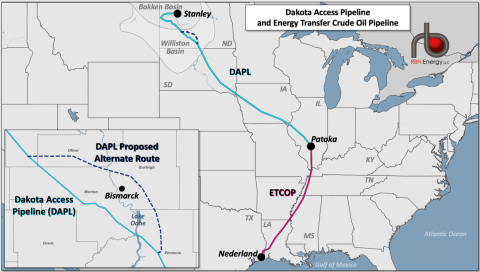Locator: 45513B.
RBN Energy: new developments in Bakken crude oil production and DAPL. Archived.
A draft environmental impact statement (DEIS) tied to a key water crossing along the Dakota Access Pipeline (DAPL) has finally been completed and made public, thereby ending another chapter in the long-running drama about the ultimate fate of DAPL, which is by far the largest crude oil pipeline out of the Bakken. While the DEIS doesn’t finish the story, the document provides hints about possible outcomes — and an opportunity to review just how important the 750-Mb/d pipeline really is to Bakken producers and shippers. In today’s RBN blog, we discuss the latest developments regarding DAPL and Bakken production.
More than 10 years ago, in Express Yourself (Dakota), we blogged about Koch Industries’ plan to help pipe crude oil all the way from western North Dakota to the Gulf Coast. The plan was complicated. It called for the development of the 250-Mb/d Dakota Express — a combination of new and repurposed Koch pipe from the Bakken to the crude hub in Patoka, IL (via Minneapolis) — and a possible connection from Patoka to Energy Transfer’s proposed Eastern Gulf Crude Access Pipeline (EGCAP), which involved the repurposing of the Trunkline natural gas pipeline to St. James, LA, and maybe a run of new pipe from there to the Louisiana Offshore Oil Port’s (LOOP) onshore storage hub in Clovelly, LA.
New takeaway capacity out of the Bakken was desperately needed — production in the shale play (aka the Williston Basin) was growing by leaps and bounds through the first half of the 2010s, forcing many shippers to resort to more expensive crude-by-rail. Koch’s proposed Bakken-to-Patoka link never happened and was later replaced by DAPL (light blue line in Figure 1 map and inset), which came online in June 2017 as a 470-Mb/d facility (see What a Difference a DAPL Makes). EGCAP morphed into ETCOP (Energy Transfer Crude Oil Pipeline; red line in map), which terminated at Nederland, TX, (not St. James) and started up the same month. DAPL and ETCOP are collectively known as the Bakken Pipeline System and are co-owned by Energy Transfer (with a ~36% share), Enbridge (~28%), Phillips 66 Partners (25%), MPLX (~9%), and ExxonMobil (~2%).
Figure 1. Dakota Access Pipeline and Energy Transfer Crude Oil Pipeline. Source: RBN
DAPL was a lifesaver for crude oil producers in western North Dakota and critical to the continued growth of the Bakken shale play. Without DAPL, a second boom in Bakken production — from less than 1 MMb/d when the pipeline became operational to nearly 1.5 MMb/d at the play’s peak in late 2019 — may well not have occurred. But the COVID shock of early 2020 and other, related factors took the wind out of the Bakken’s sails. By May 2020, production had slipped to less than 900 Mb/d, and though output rebounded later in 2020 and over the next couple of years, the Bakken’s crude output has remained largely rangebound between 1.1 MMb/d and 1.2 MMb/d — well below the late-2019 high mark.
It ain't over, til it's over. And then it still ain't over.
My hunch: this story won't be over until the DAPL is dead.
